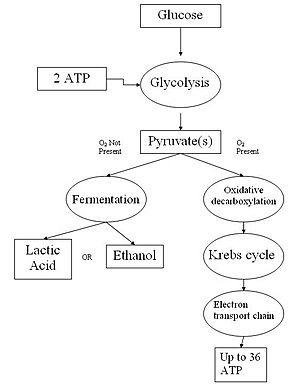Cellular respiration facts for kids
Cellular respiration is how your cells get energy from the food you eat. It's like a tiny power plant inside each cell, turning food into a special energy molecule called ATP. This ATP is the fuel your cells need to do everything, from thinking to running!
Most of the time, this process uses oxygen. We call this aerobic respiration. It happens in four main steps: glycolysis, the Link reaction, the Krebs cycle, and the electron transport chain. All these steps work together to make lots of ATP, which powers everything your cells do.
Sometimes, your cells might not get enough oxygen, like when you're exercising really hard. In these cases, they can use a different process called anaerobic respiration. This process doesn't need oxygen, but it doesn't make as much energy. It also produces lactic acid, which can make your muscles feel tired or sore.
Aerobic respiration is much more efficient. It produces a lot more energy and doesn't create lactic acid. A waste product of aerobic respiration is carbon dioxide. This carbon dioxide travels through your circulatory system to your lungs, where you breathe it out. Then, you breathe in fresh oxygen to keep the process going!
Here's a simple way to think about what happens in aerobic cellular respiration:
The scientific formula looks like this:
Aerobic cellular respiration has four important stages. Each stage builds on the one before it, making sure your cells get all the energy they need.
Contents
What are the Stages of Cellular Respiration?
The four main stages of aerobic cellular respiration are:
- Glycolysis (the first step, breaking down sugar)
- Link reaction
- Krebs cycle
- Electron transport chain, often called ETC
Glycolysis: The Sugar Breakdown
Glycolysis is the first step in cellular respiration. It happens in the cytoplasm of your cells. In this stage, a glucose molecule (a type of sugar) is broken down into two smaller molecules called pyruvate.
This process needs ten different enzymes to work through ten intermediate steps.
- First, two ATP molecules are used to kick-start the process. Think of it as investing a little energy to get a lot more later!
- By the end, you have two pyruvate molecules.
- Also, four ATP molecules are made directly during this stage.
- If oxygen is available, the pyruvate molecules move on to the next stage, the Krebs cycle, to make even more ATP.
How Much Energy Does Glycolysis Make?
While glycolysis directly makes 4 ATP molecules, it uses 2 ATP to start. So, the net gain from glycolysis is 2 ATP molecules per glucose molecule.
Link Reaction: Connecting the Stages
After glycolysis, the pyruvate molecules move into the mitochondria. Mitochondria are often called the "powerhouses" of the cell.
In the link reaction, each pyruvate molecule loses one carbon dioxide molecule and one hydrogen molecule. This changes pyruvate into an acetyl group. This acetyl group then joins with an enzyme called CoA to form acetyl CoA. This acetyl CoA is super important because it's what enters the next stage, the Krebs cycle.
Krebs Cycle: The Energy Loop
The Krebs cycle (also known as the citric acid cycle) is a repeating loop of chemical reactions. It happens inside the mitochondria.
Here's how it works:
- The acetyl CoA from the link reaction combines with another molecule called oxaloacetate. This forms a new compound with six carbon atoms.
- Through a series of steps, this six-carbon compound is broken down. Carbon dioxide is released, and energy-carrying molecules like NADH and FADH are produced.
- Because each glucose molecule produces two acetyl-CoA molecules, the Krebs cycle runs twice for every glucose molecule.
- At the end of two cycles, you get two ATP molecules, six NADH molecules, two FADH molecules, and four CO2 molecules. The ATP is direct energy, while NADH and FADH carry energy to the final stage.
Electron Transport Chain (ETC): Making the Most ATP
This is the stage where most of the ATP is made! The electron transport chain also happens inside the mitochondria.
- The NADH and FADH molecules (which are full of energy) from the previous stages deliver their hydrogen molecules and electrons to the ETC.
- These electrons move along a chain of proteins, releasing energy as they go. This energy is used to pump hydrogen ions (H+) into a special space within the mitochondria.
- This pumping creates a high concentration of hydrogen ions. Think of it like water building up behind a dam.
- Eventually, these hydrogen ions flow back into another part of the mitochondria through special protein channels. As they flow, they power a special enzyme that makes lots of ATP from ADP and phosphate.
- Finally, the electrons, hydrogen ions, and oxygen combine to form water. This is why oxygen is so important for aerobic respiration!
How Much ATP is Made?
Biology textbooks often say that about 38 ATP molecules can be made from one glucose molecule during cellular respiration. However, in reality, the process is a bit less efficient due to small energy losses. Estimates suggest that about 29 to 30 ATP molecules are actually made per glucose molecule. Even so, this is much more energy than anaerobic respiration produces!
Related Topics
Images for kids
See also
 In Spanish: Respiración celular para niños
In Spanish: Respiración celular para niños




